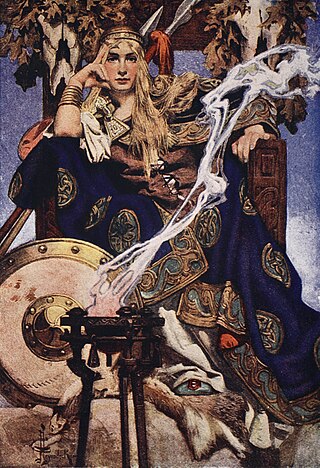Related Research Articles

Connacht or Connaught, is one of the four provinces of Ireland, in the west of Ireland. Until the ninth century it consisted of several independent major Gaelic kingdoms.
Domnall mac Causantín, anglicised as Donald II, was King of the Picts or King of Alba in the late 9th century. He was the son of Constantine I. Donald is given the epithet Dásachtach, "the Madman", by the Prophecy of Berchán.

Medb, later spelled Meadhbh, Méabh(a) and Méibh, and often anglicised as Maeve, is queen of Connacht in the Ulster Cycle of Irish mythology. Her husband in the core stories of the cycle is Ailill mac Máta, although she had several husbands before him who were also kings of Connacht. She rules from Cruachan. She is the enemy of Conchobar mac Nessa, king of Ulster, and is best known for starting the Táin Bó Cúailnge to steal Ulster's prize stud bull Donn Cúailnge.
Tadhg, commonly anglicized as "Taig" or "Teague", is an Irish and Scottish Gaelic masculine name that was very common when the Goidelic languages predominated, to the extent that it is a synecdoche for Irish-speaking man. The name signifies "poet" or "philosopher". This was also the name of many Gaelic Irish kings from the 10th to the 16th centuries, particularly in Connacht and Munster. Tadhg is most common in south-west Ireland, particularly in County Cork and County Kerry. The name has enjoyed a surge in popularity recently; in 2005 it was the 69th most common name for baby boys and in 2010 the 40th, according to the Central Statistics Office in Ireland.
Brión, son of Eochaid Mugmedón, was a legendary and possibly historical Irish king, fl. 4th/5th century.
Dluthach mac Fithcheallach was the 18th King of Uí Maine.
O'Malley may refer to:

The Uí Briúin were a royal dynasty of Connacht. Their eponymous apical ancestor was Brión, son of Eochaid Mugmedon and Mongfind, and an elder half brother of Niall of the Nine Hostages. They formed part of the Connachta, along with the Uí Fiachrach and Uí Ailello, putative descendants of Eochaid Mugmedon's sons Fiachra and Ailill. The Uí Ailello were later replaced as the third of the Three Connachta, through genealogical sleight of hand, by the Uí Maine.
John Day Collis (1816–1879) was a British headmaster and educational writer.
Events from the 9th century in Ireland.
Inreachtach mac Dluthach, 21st King of Uí Maine, died 750.
Maille mac Conall, member of the Umhaill, ancestor and eponym of the O'Malley family of County Mayo.
Domnall Ruadh Ó Máille, King of Umaill, died 11 November 1337.
Liam O Mallie, inspiration for the character of Christy Mahon in The Playboy of the Western World, fl. 1873.

Umhaill or Umhall was a Gaelic territory around Clew Bay in the west of what is now County Mayo, Ireland, comprising the baronies of Burrishoole and Murrisk. By the 12th century, its ruling dynasty were known as the Uí Máille (O'Malleys). Originally an autonomous part of the kingdom of Connacht, it later became one of the vassal territories of the Mac William Íochtar. Umhaill's last and most famous ruler was Grace O'Malley, nicknamed "the pirate queen". In 1576, during the Tudor conquest of Ireland, she agreed to the surrender and regrant policy, accepting English inheritance law in return for official title deeds to her lands. On her death the lands were inherited by her son Tibbot "na Long". Umhaill had a strong seafaring culture. Important sites associated with it include Carrickkildavnet Castle, Carrickahowley Castle, Granuaile's Castle and Clare Island Abbey.
The Kings of Umaill were rulers of Umaill, a kingdom or territory located in the west of what is now County Mayo, Ireland.
Flannabhra, King of Umaill, died 773.
Dunghal mac Flaithniadh, King of Umaill, died 776.
Flathghal mac Flannbhrath, King of Umaill, died 782.
Donell Ó Máille was King of Umaill in Ireland, and Chief of the Name.
References
- The History of Mayo, pp. 388–89, T.H. Knox, 1908.